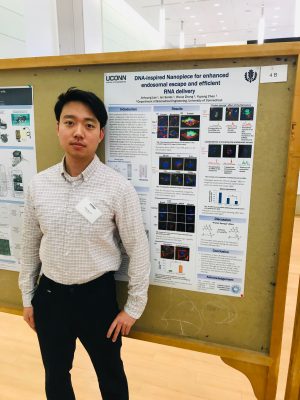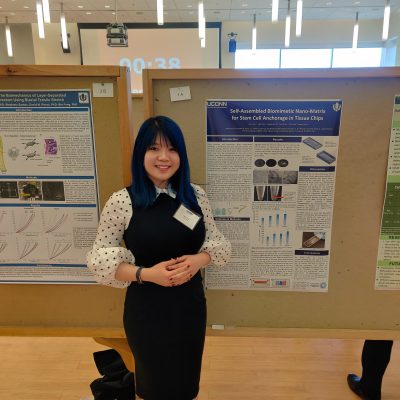Hello everyone,
I hope everything is well with everyone. It is an unprecedented time now that everything is close at UConn (Almost) I hope everyone is home safe and sound! On March 11th of 2020, right before the campus closed, Jin and I (Anne) were able to participate in SoE Poster Competition for Graduate Students!
Jin was able to present his poster on what he was doing the month before during the UCONN RNA Salon on Valentine's day! His poster presentiation titled "DNA-inspired Nanopiece for Enhanced Endosomal Escape and Efficient RNA Deliver" was great and those images are amazing 🙂 
Next, Anne (me!) is still working on the research! However, I was able to present some of my data in this presentation "Self-assembled Biomimetic Nano-matrix For Stem Cell Anchorage in Tissue Chips" Currently I am working on the development of Tissue chips to culture cells! We are at the beginning of the stage where we are making the chips with PDMS (polydimethylsiloxane) via a master mold printed from a fused deposition modelling (FDM) 3D printer - MAKERBOT that we have on campus. Then we poured liquid PDMS polymer in and let it cured to obtain a solid resin, and we can go from there! The next step would be identifying the flow rate of the media, and inserting agarose in the channels to see how feasible it is before we do cell culture!
Currently, researchers are struggling to bridge the gaps to translate preclinical data into clinical data largely due to the use of animal models in the preclinical settings. The success of animal models often do not link to the success in human trials possibly because there were lack of human cells and tissues in the animal models. Not only animal models are expensive, they are also time consuming albeit the data was needed for FDA approval.
In the past few decades, researchers have been looking into different routes to bypass the need for animals in drug development and toxin testing before heading towards clinical trials in humans. One of them is with the use of Organ-on-a-chip (OOC). OOC is a 3D microfluidic chip that can simulate organs' activities by introducing mechanical or physiological response to the chip. Currently, there are many other organs-on-chips that have been simulated by microfluidic devices such as the heart, lung, kidney, artery, bone and more. There are many advantages when it comes to using OOC instead of animal models such as it being less time consuming, erases the ethical concerns in handling animals, less expensive and many more. Although this technology is new, this is a promising approach in eliminating the use of animal models once and for all.
